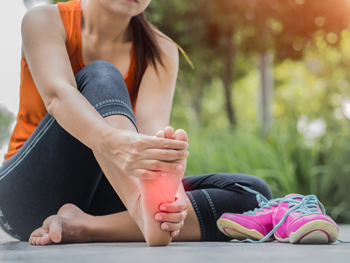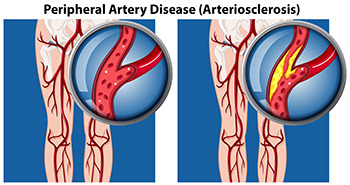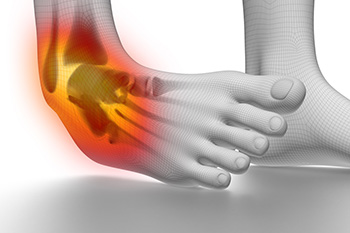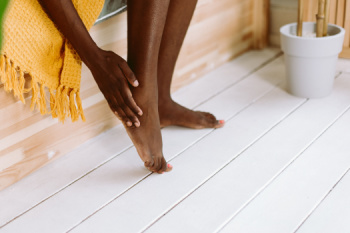- Home
- Our Doctors
- Our Offices
- New Patients
- Patient Education
- Blog
- Contact Us
- Patient Portal Help
- Product Center


Selecting the ideal running shoe with proper arch support is essential for avid runners, as it significantly reduces the risk of common injuries, such as tendonitis or shin splints. Arch support plays a pivotal role in correcting gait issues, ensuring a more efficient and comfortable running experience. When looking for running shoes, it is important to consider various factors, including terrain, distance, and individual arch type. Runners with low arches may benefit from stability shoes, which provide extra support to prevent overpronation, while those with normal or high arches may find neutral shoes more suitable. Comfort should always be a priority, regardless of arch type. To pinpoint the perfect shoe, seeking guidance from a podiatrist can help. This foot doctor can evaluate your arch type and gait pattern to determine the most suitable footwear for your needs, helping to minimize the risk of injury. If you are experiencing arch pain after a run, it is suggested that you schedule an appointment with a podiatrist for an exam and treatment options, which may include custom orthotics.
If you are a runner, wearing the right running shoe is essential. For more information, contact one of our podiatrists from Foot & Ankle Institue. Our doctors can provide the care you need to keep you pain-free and on your feet.
Choosing the Right Running Shoe for Your Foot Type
To increase performance and avoid the risk of injury, it is important to choose the right running shoe based on your foot type. The general design of running shoes revolves around pronation, which is how the ankle rolls from outside to inside when the foot strikes the ground.
If you have any questions please feel free to contact one of our offices located in St. George, Hurricane, and Cedar City, UT and Mesquite, NV . We offer the newest diagnostic and treatment technologies for all your foot and ankle needs.
Running may seem like a simple to do. However, running is actually a complex movement that puts stress on the ligaments, bones, and joints of the body. Selecting the correct running shoe is important for increasing performance and avoiding risk of injury. Running shoes should be selected based on your foot type. Considerations such as trail versus road shoes are important. Your foot type dictates the degree of cushioning, stability and motion control you require. The most accurate way to learn your foot type is to visit a local shop that specializes in running shoes. Professionals can measure your arch type, stride and gait and help you with your shoe needs.
The design of running shoes is created around the idea of pronation. Pronation is the natural rolling movement of your ankle from the outside to inside when your foot strikes the ground. If you run properly you strike the ground on the outside of your heel and roll in the direction of your big toe before pushing off once more. Pronation is beneficial because it assists the lower half of your body in absorbing shock and storing energy. Those considered neutral runners pronate correctly and do not need running shoes that help correct their form. Neutral runners can choose from a wide variety of shoes, including barefoot or minimal types. However, those who have arch problems or who adopt an incorrect form while running may experience too much or too little pronation. They may require running shoes that offer additional support.
Those who overpronate experience an over-abundance of ankle rolling. Even while standing, those who severely overpronate display ankles that are angled inward. It is not uncommon for them to have flat feet or curved legs. The tendency to overpronate may cause many injuries. Areas that tend to become injured are the knees, ankles, and Achilles tendon. If you find that you have a tendency to overpronate, you should look at shoes that provide extra stability and motion-control. Motion-control shoes are straight and firm. Shoes of this type do not curve at the tip. The restricted flexibility along the middle of the shoe prohibits the foot from rolling too far inward as your foot strikes the ground.
A less common problem is underpronation. Underpronation, also called supination, is when the feet are unable to roll inward during landing. Those who underpronate have feet that lack flexibility and high arches. This prevents any kind of shock absorption, even though it does place less rotational stress on ankles and knees. This added force can cause fractures, ligament tears, and muscle strains because the legs are trying to compensate for the impact. Those who underpronate need shoes with more cushioning and flexibility. If you have a tendency to underpronate, selecting stability or motion-control shoes may cause you more problems by continuing to prevent pronation.
 Wearing high heels to work every day can have a significant effect on the feet and the rest of the body. High heels shift body weight forward, increasing pressure on the forefoot and leading to conditions like bunions, hammertoes, and metatarsalgia. The unnatural angle of the foot can cause calf muscle tightening and Achilles tendon shortening, resulting in discomfort and pain. Over time, high heels can alter posture, leading to lower back, hip, and knee pain due to misalignment of the spine and joints. Wearing high heels may seem glamorous, but it can also cause pain, blisters, and calluses. To mitigate these effects, choose heels with lower heights, opt for wedges or platforms for better weight distribution, and use cushioned insoles. It can also help to regularly stretch the calves and feet, and alternating with more supportive footwear. If you enjoy wearing heels to work and you have persistent foot pain, it is suggested that you schedule an appointment with a podiatrist for advice and care.
Wearing high heels to work every day can have a significant effect on the feet and the rest of the body. High heels shift body weight forward, increasing pressure on the forefoot and leading to conditions like bunions, hammertoes, and metatarsalgia. The unnatural angle of the foot can cause calf muscle tightening and Achilles tendon shortening, resulting in discomfort and pain. Over time, high heels can alter posture, leading to lower back, hip, and knee pain due to misalignment of the spine and joints. Wearing high heels may seem glamorous, but it can also cause pain, blisters, and calluses. To mitigate these effects, choose heels with lower heights, opt for wedges or platforms for better weight distribution, and use cushioned insoles. It can also help to regularly stretch the calves and feet, and alternating with more supportive footwear. If you enjoy wearing heels to work and you have persistent foot pain, it is suggested that you schedule an appointment with a podiatrist for advice and care.
High heels have a history of causing foot and ankle problems. If you have any concerns about your feet or ankles, contact one of our podiatrists from Foot & Ankle Institue. Our doctors can provide the care you need to keep you pain-free and on your feet.
Effects of High Heels on the Feet
High heels are popular shoes among women because of their many styles and societal appeal. Despite this, high heels can still cause many health problems if worn too frequently.
Which Parts of My Body Will Be Affected by High Heels?
What Kinds of Foot Problems Can Develop from Wearing High Heels?
How Can I Still Wear High Heels and Maintain Foot Health?
If you want to wear high heeled shoes, make sure that you are not wearing them every day, as this will help prevent long term physical problems. Try wearing thicker heels as opposed to stilettos to distribute weight more evenly across the feet. Always make sure you are wearing the proper shoes for the right occasion, such as sneakers for exercising. If you walk to work, try carrying your heels with you and changing into them once you arrive at work. Adding inserts to your heels can help cushion your feet and absorb shock. Full foot inserts or metatarsal pads are available.
If you have any questions please feel free to contact one of our offices located in St. George, Hurricane, and Cedar City, UT and Mesquite, NV . We offer the newest diagnostic and treatment technologies for all your foot and ankle needs.
It is no secret that high heels are uncomfortable to wear for long periods of time. Although beauty is pain, you should not sacrifice the health of your feet for a stylish heel. Wearing high heels can potentially cause many different foot conditions that may be avoided by wearing proper footwear.
The structure of high heels forces weight of your body to get shifted forward toward the ball of the foot. The higher the heel you wear, the more weight and pressure get shifted forward. The pressure that your toes may experience from wearing heels may lead to hammer toes, bunions, and ingrown toenails. Extra weight and pressure resulting from wearing heels may cause stress fractures. Furthermore, heels may cause pinched nerves which may result in Morton’s neuroma.
High heels are even more dangerous for people who are clumsy. Falling or tripping while wearing heels can cause an ankle sprain or twist.
What many people don’t know is that heels can also cause back and knee problems. In order for your body to stay balanced on heels, your spine has to sway unnaturally, which adds stress to your spine muscles. This may cause you to experience a sore lower back.
If you decide to wear high heels regardless of the risks associated with them, there are ways you can minimize their harmful effects. One way to reduce injury is to massage and stretch your legs at the end of the day. Stretching can prevent the Achilles tendons and calf muscles from becoming too tight. If you are simply looking for more height, wedges and platforms provide a better surface area to distribute the body weight across compared to thinner heels.
If you experience pain from wearing high heels, it is important to see a podiatrist before any of your symptoms become worse.

Peripheral artery disease, or PAD, is a prevalent vascular condition characterized by narrowed arteries that limits blood flow to the extremities (including the feet). The restricted blood flow deprives the feet of oxygen and vital nutrients, leading to a range of symptoms. Individuals with PAD may experience intermittent claudication, a condition marked by pain or cramping in the legs or feet during physical activity but subsides with rest. Other symptoms can include numbness, tingling, or weakness in the feet, particularly while at rest or during nighttime. As PAD progresses, individuals may develop non-healing wounds or ulcers on the feet, which pose a risk of infection and tissue damage. Recognizing the symptoms of PAD and seeking timely medical intervention is essential in managing the condition and preserving foot health. Regular exercise, smoking cessation, and medication management are among the strategies employed to lessen PAD's effects and improve overall vascular health. If you have tingling or numbness in your feet, it is suggested that you visit a podiatrist who can diagnose and help you to manage PAD.
Peripheral artery disease can pose a serious risk to your health. It can increase the risk of stroke and heart attack. If you have symptoms of peripheral artery disease, consult with one of our podiatrists from Foot & Ankle Institue. Our doctors will assess your condition and provide you with quality foot and ankle treatment.
Peripheral artery disease (PAD) is when arteries are constricted due to plaque (fatty deposits) build-up. This results in less blood flow to the legs and other extremities. The main cause of PAD is atherosclerosis, in which plaque builds up in the arteries.
Symptoms
Symptoms of PAD include:
It is important to note that a majority of individuals never show any symptoms of PAD.
Diagnosis
While PAD occurs in the legs and arteries, Podiatrists can diagnose PAD. Podiatrists utilize a test called an ankle-brachial index (ABI). An ABI test compares blood pressure in your arm to you ankle to see if any abnormality occurs. Ultrasound and imaging devices may also be used.
Treatment
Fortunately, lifestyle changes such as maintaining a healthy diet, exercising, managing cholesterol and blood sugar levels, and quitting smoking, can all treat PAD. Medications that prevent clots from occurring can be prescribed. Finally, in some cases, surgery may be recommended.
If you have any questions, please feel free to contact one of our offices located in St. George, Hurricane, and Cedar City, UT and Mesquite, NV . We offer the newest diagnostic and treatment technologies for all your foot care needs.
Peripheral artery disease (PAD), or peripheral arterial disease, is a circulatory problem in which there is a reduction of blood flow to the limbs due to narrowed arteries. When peripheral artery disease develops, the extremities do not receive enough blood flow; this may cause symptoms to develop such as claudication, or leg pain when walking. The legs are the most common site of peripheral artery disease.
Claudication, or leg pain when walking, is one of several symptoms that can develop due to peripheral artery disease. Other symptoms caused by the disease include painful cramping in the hips, thighs, or calves after certain activities; leg numbness or weakness; coldness in the lower leg or foot; sores on the lower extremities that do not heal; hair loss on the lower extremities; and a missing or weak pulse in the lower extremities. In more severe cases, pain may even occur when the body is at rest or when lying down.
Peripheral artery disease is typically caused by atherosclerosis, a condition in which fatty deposits build up in the arterial walls and reduce blood flow. Smoking, diabetes, obesity, high blood pressure, and high cholesterol are some of the risk factors for peripheral artery disease.
If you are experiencing pain, numbness, or other symptoms in the lower extremities, see your healthcare professional immediately. Diagnosed peripheral artery disease can be treated with various medications, angioplasty and surgery, exercise programs, or alternative medicine. It is important to consult a healthcare professional to determine the best treatment for you.
 Severe ankle sprains that do not respond well to conservative treatment methods, such as rest and elevation, may require surgical intervention to restore stability and function to the ankle. A podiatrist, or foot doctor, might suggest surgical procedures like arthroscopy, where a small camera and instruments are inserted through tiny incisions to visualize, diagnose, and repair damage to the ligaments inside the ankle. Severe tearing of the ligaments may require reconstructive surgery, which involves replacing the damaged ligament with a tendon graft taken from another part of the body or using synthetic materials to stabilize the ankle. These surgical options aim to alleviate pain, restore stability, and prevent chronic issues such as ankle instability or recurrent sprains. Post-surgery, a rehabilitation program with targeted exercises to strengthen the muscles around the ankle is important. This helps patients who have undergone ankle surgery regain full mobility and recover successfully. If you have a sprained ankle, it is suggested that you make an appointment with a podiatrist promptly for proper care.
Severe ankle sprains that do not respond well to conservative treatment methods, such as rest and elevation, may require surgical intervention to restore stability and function to the ankle. A podiatrist, or foot doctor, might suggest surgical procedures like arthroscopy, where a small camera and instruments are inserted through tiny incisions to visualize, diagnose, and repair damage to the ligaments inside the ankle. Severe tearing of the ligaments may require reconstructive surgery, which involves replacing the damaged ligament with a tendon graft taken from another part of the body or using synthetic materials to stabilize the ankle. These surgical options aim to alleviate pain, restore stability, and prevent chronic issues such as ankle instability or recurrent sprains. Post-surgery, a rehabilitation program with targeted exercises to strengthen the muscles around the ankle is important. This helps patients who have undergone ankle surgery regain full mobility and recover successfully. If you have a sprained ankle, it is suggested that you make an appointment with a podiatrist promptly for proper care.
Foot surgery is sometimes necessary to treat a foot ailment. To learn more, contact one of our podiatrists of Foot & Ankle Institue. Our doctors will assist you with all of your foot and ankle needs.
When Is Surgery Necessary?
Foot and ankle surgery is generally reserved for cases in which less invasive, conservative procedures have failed to alleviate the problem. Some of the cases in which surgery may be necessary include:
What Types of Surgery Are There?
The type of surgery you receive will depend on the nature of the problem you have. Some of the possible surgeries include:
Benefits of Surgery
Although surgery is usually a last resort, it can provide more complete pain relief compared to non-surgical methods and may allow you to finally resume full activity.
Surgical techniques have also become increasingly sophisticated. Techniques like endoscopic surgery allow for smaller incisions and faster recovery times.
If you have any questions please feel free to contact one of our offices located in St. George, Hurricane, and Cedar City, UT and Mesquite, NV . We offer the newest diagnostic and treatment technologies for all your foot and ankle needs.
In most cases, foot surgery is often chosen as the last available option for conditions that have otherwise been unsuccessfully treated. Surgery may be necessary for several reasons, including the removal of foot deformities (e.g. bone spurs or bunions), arthritis problems, reconstruction due to injury, and congenital malformations (e.g. club foot or flat feet). Regardless of one’s age, foot surgery may be the only successful option for treatment for certain conditions.
The type of surgery one undergoes depends on the type of foot condition the patient has. For the removal of a bunion growth, a bunionectomy is necessary. If the bones in the feet need to be realigned or fused together, a surgical fusion of the foot is needed. For pain or nerve issues, a patient may require surgery in which the tissues surrounding the painful nerve are removed. Initially, less invasive treatments are generally attempted; surgery is often the last measure taken if other treatments are unsuccessful.
While in many cases surgery is often deemed as the final resort, choosing surgery comes with certain benefits. The associated pain experienced in relation to the particular condition is often relieved with surgery, allowing patients to quickly resume daily activities. The greatest benefit, however, is that surgery generally eliminates the problem immediately.
Podiatry history has shown that foot treatments continue to evolve over time. In the field of foot surgery, endoscopic surgery is just one of the many advanced forms of surgery. As technology vastly improves so too will the various techniques in foot surgery, which already require smaller and smaller incisions with the use of better and more efficient tools. Thanks to such innovations, surgery is no longer as invasive as it was in the past, allowing for faster and easier recoveries.
 Ankle pain can be a symptom of various types of arthritis, each with distinct characteristics and causes. Osteoarthritis, often associated with aging, occurs when the protective cartilage cushioning the ends of the bones wears down over time. This leads to pain and stiffness in the ankle. Rheumatoid arthritis, or RA, is an autoimmune condition where the immune system mistakenly attacks the joints, including those in the ankle. Inflammation, swelling, and pain in the ankles are common symptoms. Gout, another form of arthritis, is caused by the buildup of uric acid crystals in the joints. This condition can lead to sudden, severe attacks of pain and redness in the ankle. There are different treatment strategies for each type of arthritis, including medication and lifestyle changes. In some cases, surgery may be necessary to relieve symptoms and improve joint function. A podiatrist, or foot doctor, can help diagnose the specific type of arthritis causing ankle pain through clinical evaluation and imaging tests. If you have ankle pain, it is suggested that you make an appointment with a podiatrist for diagnosis and a personalized treatment plan.
Ankle pain can be a symptom of various types of arthritis, each with distinct characteristics and causes. Osteoarthritis, often associated with aging, occurs when the protective cartilage cushioning the ends of the bones wears down over time. This leads to pain and stiffness in the ankle. Rheumatoid arthritis, or RA, is an autoimmune condition where the immune system mistakenly attacks the joints, including those in the ankle. Inflammation, swelling, and pain in the ankles are common symptoms. Gout, another form of arthritis, is caused by the buildup of uric acid crystals in the joints. This condition can lead to sudden, severe attacks of pain and redness in the ankle. There are different treatment strategies for each type of arthritis, including medication and lifestyle changes. In some cases, surgery may be necessary to relieve symptoms and improve joint function. A podiatrist, or foot doctor, can help diagnose the specific type of arthritis causing ankle pain through clinical evaluation and imaging tests. If you have ankle pain, it is suggested that you make an appointment with a podiatrist for diagnosis and a personalized treatment plan.
Ankle pain can be caused by a number of problems and may be potentially serious. If you have ankle pain, consult with one of our podiatrists from Foot & Ankle Institue. Our doctors will assess your condition and provide you with quality foot and ankle treatment.
Ankle pain is any condition that causes pain in the ankle. Due to the fact that the ankle consists of tendons, muscles, bones, and ligaments, ankle pain can come from a number of different conditions.
Causes
The most common causes of ankle pain include:
Symptoms
Symptoms of ankle injury vary based upon the condition. Pain may include general pain and discomfort, swelling, aching, redness, bruising, burning or stabbing sensations, and/or loss of sensation.
Diagnosis
Due to the wide variety of potential causes of ankle pain, podiatrists will utilize a number of different methods to properly diagnose ankle pain. This can include asking for personal and family medical histories and of any recent injuries. Further diagnosis may include sensation tests, a physical examination, and potentially x-rays or other imaging tests.
Treatment
Just as the range of causes varies widely, so do treatments. Some more common treatments are rest, ice packs, keeping pressure off the foot, orthotics and braces, medication for inflammation and pain, and surgery.
If you have any questions, please feel free to contact one of our offices located in St. George, Hurricane, and Cedar City, UT and Mesquite, NV . We offer the newest diagnostic and treatment technologies for all your foot care needs.
Having issues or need help with your portal?
Click here for Instructional Videos